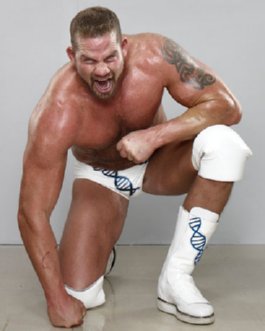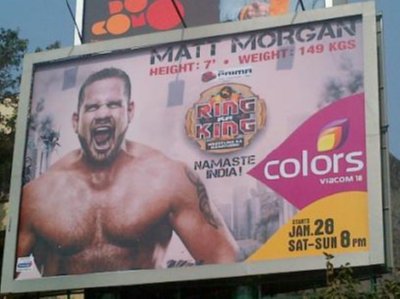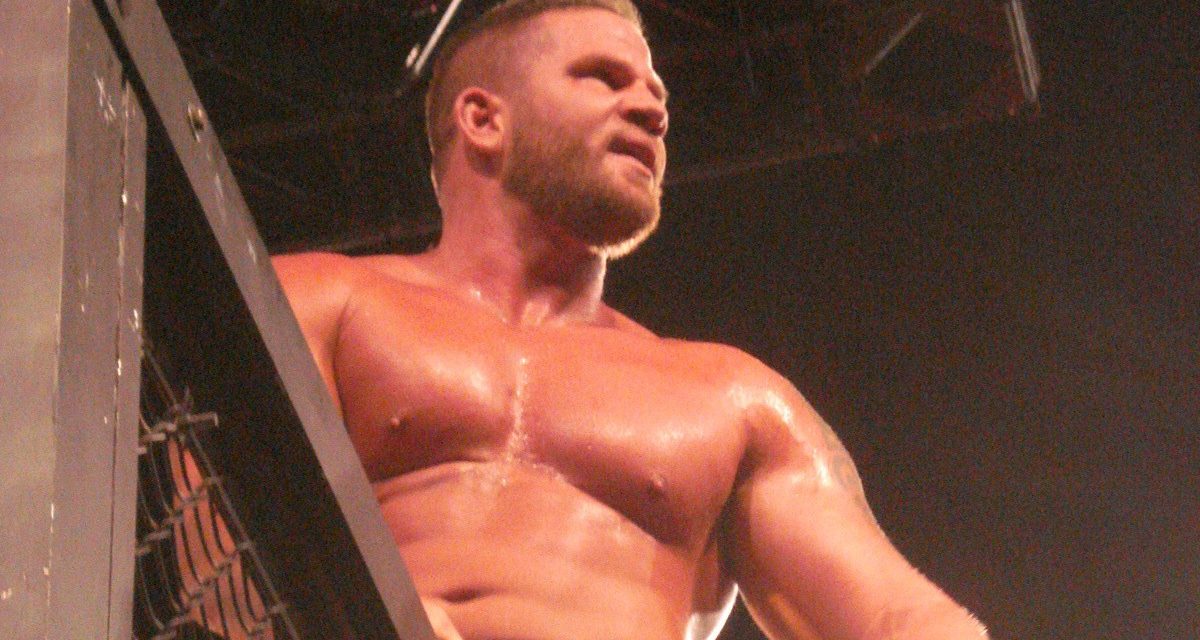At seven feet tall, standing head and shoulders above most people is fairly routine for Matt Morgan. But what would be special is to stand head and shoulders above the entire wrestling world. His first step? Dominating the competition in TNA’s Indian promotion Ring ka King.
“Never in my wildest imagination growing up as a kid did I think that I would be wrestling on national television every week,” he told SLAM! Wrestling in an exclusive interview, “let alone in India. And to see how successful it’s become — to be literally the most watched wrestling program in the world? I mean, how could I have ever imagined that?”

Matt Morgan, Ring ka King star.
By most accounts, the company’s foray into India has been a positive one, in terms of ratings and in overall buzz. Its success, Morgan says, can be attributed in part to a couple of basic factors: the roster, and the relative simplicity of its matches and storylines.
In terms of roster, in addition to Morgan, there are a number of other TNA stars, some well-known names that were brought in specifically for King, and a number of home-grown Indian stars. As for his involvement, Morgan explained that he wasn’t originally planned to be on the show.
“Jeff Jarrett was the only real top name that was on the original list to go out there,” he explained. “There was this local Hindi talent who’s a huge celebrity over there, like the Brad Pitt of India, and he was supposed to be involved with the show. Something happened — either he was sick or something — and he wasn’t able to do it, so they needed to send over some more recognizable faces.”
Others that went along for the trip are Brutus Magnus, Scott Steiner, and Mickie James. A few other non-TNA talents were also brought over, a mix of well-known names like Sonjay Dutt, Chavo Guerrero, Harry Smith, James (Nunzio) Maritato, and Chris (Masters) Mordetzky, and some lesser known talents like Canada’s Bollywood Boys (Canadians Gurv and Harv Sihra).”
While traveling the world is old hat to Morgan, for some of the others, it was a brand new experience.
“I was very fortunate to start with WWE the way I did,” he said. “I started on the road pretty much straight away, and I got to tour in all of these foreign markets — Europe, Japan, Korea, Australia. Then when I left WWE, before I started in TNA, I spent two straight years in Japan. I mean every month, I was in Japan wrestling, for New Japan, Hustle, or All Japan. In that two years, I spent about a full year actually living there — two weeks of every month. But for some of the guys who haven’t had the opportunity to travel, Ring ka King is a cool experience.”
Luckily, the King crew had a lot of help with acclimatizing themselves in India. So the experience was much easier than some of the stories he’d heard about the infamous 2003 WWE tour of India, during which many of the roster got seriously ill.
“I don’t think any of us got sick,” he remembered. “We were very educated on what to expect and how to avoid that. Sonjay Dutt, who understands the lay of the land over there, was very helpful in that regard. Plus, we had a great group of locals there that helped us. They kept us away from anything that would hurt us like that.”
The locals also made up the rest of the roster. That resulted in its own challenges, he said, since many of them were very inexperienced. To get them up to speed, they went through a wrestling crash course before their TV debuts.
“They’re green,” he said simply. “But, to clarify, that’s not an insult. I think there’s an unfairly negative connotation out there about the term ‘green.’ Jim Ross told me that there’s nothing wrong about being green, it just means you’re new, you’re inexperienced. Now, if you’ve been wrestling for 15 years and you’re still green, well that’s a different story. A lot of them are green, they’re very new to this. But a few of them have caught on a lot quicker than anyone could have expected, and I think you’ll see that. From where someone should be maybe six months in, a lot of them have exceeded expectations.”
“I give them a lot of credit,” he said. “Even with an interpreter to help, there’s a language barrier. Add that to the inexperience — some of them don’t know the names of certain moves — that can be a challenge. But that’s not anyone’s fault, that’s just the situation we’re in. And that’s part of our job to help train them. We have the right guys, I think, to be in that situation and help them through those barriers to the point that they’re comfortable enough to learn how to perform in the ring. It’s definitely a work in progress. A couple of them were better able to pick things up quicker than the others, but that doesn’t mean that those other guys won’t get there.”
What helped the Indian crew learn the ropes, if you will, is the fact that the company is sticking to the basics. Notable when watching King is the relative simplicity of the show. With its basic storylines and clear delineation between heroes and villains, it’s a refreshing change from any other show out there — including TNA’s very own Impact program. This was strictly by design, Morgan revealed.
“Part of what we’re doing is educating the local Indian wrestling fans. We’re able to start at the starting line, and show them the basics of pro wrestling. No over-booking, no doing swerves for the sake of doing a swerve — because that would confuse the hell out of them, they wouldn’t even know how to react to that. It’s very well scripted, very well presented, and it works.”
While some North American fans may find the show almost too basic, Morgan believes the mix is appropriate — especially for the viewers in India for whom this show is primarily intended for.
“There are some people who are here and maybe watch in on YouTube or on the Colors network on satellite, and some of them may think that it’s too basic,” he acknowledged. “But I’ve I’ve always been a firm believer that you need to have established bad guys and established good guys, black versus white, good versus evil. If you do that, I think that everybody wins. Even the fans that have been watching wrestling for years, they say the same thing. They would prefer to see established characters stay in their lane without the mish-mashing into a grey area.”
“Yes, there comes a time when that is needed, sure, but you can’t have every character do that, or it causes utter confusion. It’s hard to emotionally invest in a character like that, because you need to have a certain level of predictability as a character so that fans can really identify with you. The only way fans can identify with Matt Morgan is if they can almost guess what I’m thinking and what I’m going to do if somebody comes up to me and trash talks me, or slaps me in the face. If a fan can predict what good guy Matt Morgan is going to do, that’s a good thing, because they will pay to see it next week, they’re going to pay to see that bad guy get his comeuppance. Sticking to the basics has always worked, it’s worked since the 1800s, there’s no reason to get entirely away from that.”
If the crowd reactions are any indication, then the formula is certainly working. Throughout the broadcast, the fans are cheering and booing, seem legitimately frightened by the heels (numerous times, Scott Steiner and Abyss will jump into the crowd and send them scattering), and supportive of the heels. No more was this evident when Morgan won the tournament to crown the inaugural World Heavyweight Championship and the crowd went crazy.

Morgan was chosen as one of the faces of Ring ka King for its promotional campaign.
As excited as they were, the person that was most pleased by the win was Morgan himself. He had finally won a world title, and in doing so achieved one of his long-time career goals.
“Whoa, whoa, what about OVW, buddy?” he jokingly objected. “No, I’m kidding. In terms of being the hood ornament of a company, yes, this is my first true Heavyweight Championship. I’m very honoured that I was the inaugural champion. I had no idea it was happening. Jeff Jarrett had been calling me ‘champ’ for a couple of weeks before that. He’d call me that in the back, and I thought he was kidding around because I had just won the Tag Team Championship with Crimson. Then I get to India, and I hear I’m going to win the Heavyweight Championship. To be the first guy to hold the title, I’m very blessed by that and very fortunate for that.”
Morgan has since lost the title, but holding it while he did, it gave him a small taste of gold that he ultimately wants to surround himself in.
“I’m very happy, but you’d be mistaken to think I don’t want more. I want the World Heavyweight Championship of Impact Wrestling,” he declared firmly, “and I’m damn sure going to get it. My goal is to do be the biggest name in this business. And to do whatever it takes — to eat, breathe and live this business. I’ve said it before: I came out of my momma’s womb a future world champion. I’m still waiting, and it’s going to come my way. When TNA puts me anywhere near that world title, I’m taking it, and I’m not letting go of it for a long, long time.”
In the meantime, though, if recent weeks have been any indication, Morgan’s immediate future involves another TNA giant in the form of Crimson. The two have feuded and teamed together, most recently at the Victory Road pay-per-view (this interview was held the week before the show). The pairing with Crimson is one that some fans have questioned, noting the relative inexperience of Crimson makes him a star that doesn’t deserve such a high profile role. But Morgan disagrees.
“I’m 7 feet tall, 300 pounds, the biggest guy in TNA. Crimson is new, an upstart rookie, undefeated, big, strong, and all that good stuff. Eventually, as is the way that it always works, people want to see two big guys go at it and see what happens. There are still fans out there that enjoy that. When I was a kid, every angle that I liked was two big dudes going at it. Thinks like Hogan-Andre, Andre versus Big John Studd. That’s what captured my imagination.”
Morgan also offered praise for Crimson’s abilities and accomplishments that he thinks haven’t necessarily been fully appreciated — while agreeing that there is still some work to be done.
“He’s a fast learner, he has a pretty good aptitude, he’s very athletic. I think he’s one of those guys like Edge that he’s a big guy, and can work like a big guy, but he can also fit in that mold like Edge.”
“And he’s still learning, trying to find his way, and trying to get comfortable with who that Crimson character is — and that takes a while. It took me a lot of time — sure I was the ‘Blueprint’ Matt Morgan in OVW, but I really couldn’t tell you back then what that character was all about. I think Crimson is going through that right now, and I think it’s cool that I get to help him along the way. I’ve helped him get a little more comfortable in the ring, and in trying to get him to work a little big bigger at times. He’s picking it up really quickly. I think he’s getting it, and I think he’ll be okay at the end of it.”
As for whether his dealings with Crimson, as friend or foe, means that he won’t ever get a title opportunity, Morgan doesn’t let himself get frustrated. “He knows that it will come in due course. He, and his fans, just need to be patient.”
“I get e-mails and tweets from fans who want to see me as world champion and complain that I should be in title matches and in main events,” he said, “and that’s what your fans are going to say. And I tell them something that I learned from Eric Bischoff. He put it this way, and it makes perfect sense. Let’s say we’re telling the story of Matt Morgan, the brand. It’s a huge book, because I’m going to have a long career. Right now, we’re at Chapter 5, let’s say. Well, Chapter 6 or 7 might be the one where I get the Heavyweight Championship. But to get there, we have to read through all of the chapters that come before it, and go through that story. So when I do win the title in Chapter 6 or 7, it will mean a hell of a lot more. We’re in the business of telling that story. I tell my fans that if they’re truly fans of mine, they’ll stay with the story, and not feel the need to skip ahead over the chapters leading up to that. That they should read the whole, entire thing, and not just the Cliff Notes version. Because if they do, I promise that when we get to the chapter when I eventually do win the Heavyweight Championship, it’ll be all worth it.”
Another thing that makes it all ‘worth it’, on a personal level, is Morgan’s involvement with charities. In particular, his work with the organization Children and Adults with Attention Deficit/Hyperactivity Disorder (CHADD). Morgan himself had Attention Deficit Disorder (ADD), so he knows what good works the organization can do.
“I grew up my entire life with severe ADD. From grade one to five, I was in a learning disabled class — I wasn’t able to learn. But once I learned how Matt Morgan learned, how to retain information the way someone with ADD does it, I became an honours student from grade six until I graduated from college, which I did magna cum laude. By being a spokesman for CHADD, I give back to the ADHD teachers that helped me. I reach out to kids, students, teachers, doctors, scientists. Anyone who is doing research or a book or anything to study ADHD, will reach out to me for a quote, or to answer questions out about my own past and how I overcame certain obstacles. I’m very honoured to be involved.”
He’s also a living example of the good work of D.A.R.E., the Drug Abuse Resistance Education program. A recovering addict himself (“I just celebrated my fifth year anniversary of being sober,” he said proudly), Morgan will often go to schools and tell the kids his story. He also shares his experience with any fellow wrestler who seeks his advice or encouragement.
“As a pro wrestler, you’ve got to realize that’s part of the deal, you’re going to wake up in pain. I rationalized that pain to start using drugs to numb my feelings, in order to get high for the sake of getting high. Lo and behold, it turned into a full-blown addiction. I went and got help. I thought if I can do that, what a hell of a great example I can be to other guys that either are going through pain killer addiction issues themselves, or to kids who haven’t even come up to that point where they’ve gotten an injury and need pain-killers. I’m a big advocate for drug-free wrestling, and I’m very proud that I can be able to help.”
In fact, the only thing he can’t live without now is being in the ring, entertaining the fans around the world. And he loves to hear from them on Twitter at @TNAMattMorgan.
“That’s the only legitimate social media I have,” he confirmed. “Anything else on Facebook or whatever is fake. I keep a pretty good job getting back to people on Twitter. I appreciate hearing from people, getting their reactions. But what I really like is to hear their reactions from the live crowd when I’m in the ring. The adrenaline you get when you’re in the ring — oh my God, that’s a drug that I’m still addicted to. And I’ll always be.”
- Dec. 15, 2012: Morgan makes an impact on willing students
- Mar. 16, 2012: Morgan talks tag teams and Victory Road
- Sep. 9, 2009: Matt Morgan at home with TNA cards
- Children and Adults with Attention Deficit/Hyperactivity Disorder website
Bob Kapur stands over five feet tall, isn’t quite 300 pounds, hasn’t traveled to India since 1990, and has never won a singles title. Hope springs eternal, though. E-mail him your pipe dreams at bobkapur@hotmail.com.

